Everglades City, Florida - 2011
Updated: 06/16/11
Our
day trip to Everglades City covered 173 miles on another nice sunny day. While
the lack of rain was not appreciated by the southern Florida residents, especially the
farmers, for us tourists, it created a series of beautiful sunny, dry days for
visiting the various attractions.
Fred continued to call our destination Alligator City because we were told we would see a lot of alligators in the area. From the photograph at the right, you can see we did have the opportunity to view alligators in their natural habitat.
The links below will move you around the page if you want to return directly to a section of interest.
Everglades City Everglades National Park Big Cypress National Preserve Ochopee Post Office
We drove to Everglades City using Route 25 leaving westbound I-75 at Exit #80. Several segments of Route 25 were fenced due to a heavy population of panthers. Apparently, in the past, the panthers were not careful enough crossing the road and the fence was erected to protect them.
Fred thinks we need an airboats for use at the cottage.
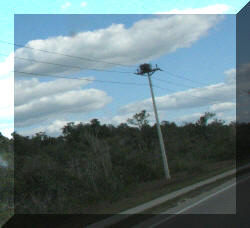 A
nest on a utility pole . . .
A
nest on a utility pole . . .
On the road into the city, we got our first look at some of the homes on stilts.
The city had an assortment of homes - as mentioned some were on silts, some not - some large, some small.
The city municipal building was impressive looking.
Everglades National Park . . .
The Gulf Coast Visitor Center of Everglades National Park included an information center, gift shop, snack bar and boat launch. A small elevator was available to take visitors to the second floor where all of the exhibits were located. It seemed strange that it required people to go up to the second floor . . . then you remember, this is an area where some houses are built on stilts.
The video was presented in a very informal way - a television in a corner of the exhibit room playing a DVD. With all the people talking, including the rangers giving directions to other visitors, it was very difficult to hear the narrative on the DVD.
Fire ant eggs . . .
What we did learn was that this is the first national park that was established to protect a threatened ecological system. It was created in 1947 to save part of the everglades. The everglades future depends on a healthier, more naturally functioning eco system in the entire region. There was a lot to be learned about the need to preserve this amazing area and the problems associated with this project. It is much more complex than we want to get into here. Suffice to say - man and nature are at crossed purposes in Florida. Mary Lou liked one sign that said "The Everglades are on life support and their survival is uncertain".
T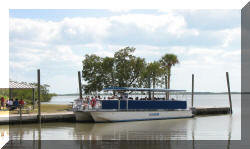 he boat tours were very popular. The Ten Thousand Island Cruise
lasts 1-1/2 hours ($25.60) and the Mangrove Wilderness Tour lasting 1-3/4 hours
($35.00). You can also rent canoes and kayaks. There is navigation information
available for those who wish to use their own water craft. We chose not to take
one because we did not
think it would compare favorably with the fun and things was saw at
Billie Swamp Safari
a few days earlier.
he boat tours were very popular. The Ten Thousand Island Cruise
lasts 1-1/2 hours ($25.60) and the Mangrove Wilderness Tour lasting 1-3/4 hours
($35.00). You can also rent canoes and kayaks. There is navigation information
available for those who wish to use their own water craft. We chose not to take
one because we did not
think it would compare favorably with the fun and things was saw at
Billie Swamp Safari
a few days earlier.
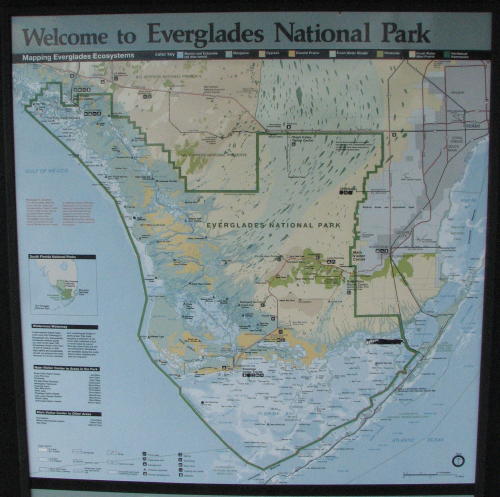 Everglades
National Park includes 1.5 million acres of land and submerged area.
The Everglades is not a proverbial swamp many people consider it to be. It
is technically a river. Originally, it was 50 miles wide and a few inches deep,
fed by Lake Okeechobee. It flowed southwest at a slow rate of about a quarter mile
a day.
Everglades
National Park includes 1.5 million acres of land and submerged area.
The Everglades is not a proverbial swamp many people consider it to be. It
is technically a river. Originally, it was 50 miles wide and a few inches deep,
fed by Lake Okeechobee. It flowed southwest at a slow rate of about a quarter mile
a day.
Everglades National Park has five visitor's centers and offers a variety of opportunities for outdoor recreation. Depending on where you are in the park there are walking trails, a tram ride, biking, boating, fishing, canoeing, and the wilderness waterway. The various visitor's centers offer more information about the accessibility for these activities.
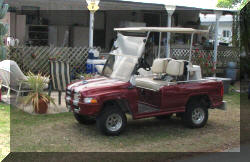 We toured the little town of Chokoloskee a little farther south before looking for alligators. That was
where we saw this golf cart parked on a side street. Our Club Car would look nice with a
Dakota style body on it.
We toured the little town of Chokoloskee a little farther south before looking for alligators. That was
where we saw this golf cart parked on a side street. Our Club Car would look nice with a
Dakota style body on it.
Big Cypress National Preserve . . .
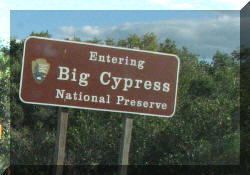
It
is a 720,000 acre Unites States National Preserve. Big Cypress, along with
Big Thicket National Preserve in Texas, became
the first national preserves in the
United States National Park System when they
were established on October 11, 1974
Big Cypress borders the wet freshwater prairies of The Everglades to the south. When Everglades National Park was established in 1947, Big Cypress was originally intended to be included; however, because the land had not been purchased from its private owners, Big Cypress was ultimately released from the park system.
A short distance east on US-41, the "Old Alligator Alley", we saw cars pulled off on the shoulder of the road. We joined them.
We watched as two manatees approached each other from opposite directions. They just glided past each other without any indication that the other one existed.
A little farther east on Route US-41, we headed north on Turner River Road. A volunteer ranger stationed at the HP Williams Rest Area was answering questions from visitors.
It looks like habitat for alligators doesn't it?
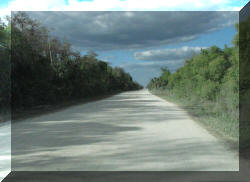 Turner
River Road continued all the way to I-75. He advised us not to drive the entire length of the road - we will have
seen enough alligators in the first mile.
Turner
River Road continued all the way to I-75. He advised us not to drive the entire length of the road - we will have
seen enough alligators in the first mile.
Yep, another anhinga drying its wings.
And yes, we did see alligators . . . click on the thumbnail photographs for an enlarged view.
This
one actually moved - its tail.
This alligator is in the trees to the left
in the larger photograph.
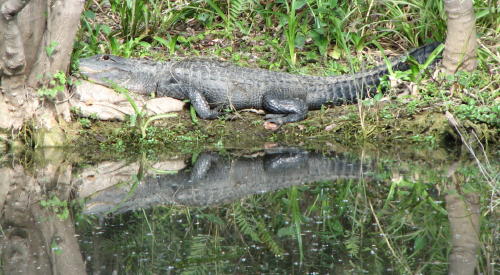 Ah,
a pillow for my head . . .
Ah,
a pillow for my head . . .
aka: A rock . . .
Notice water line across the water . . . winter is the 'dry' season in the Everglades.
A very popular bank . . .
A turtle joined them . . .
This photograph begins a 'sad' story.
Fred saw this alligator sunning himself on our side of the river. And, there
was a path leading to the river's edge.
He zoomed in on the alligator for a couple photographs.
Then proceeded down the path.
Expecting the alligator to head for deeper water as he approached, he had the camera set to rapid frames and ready.
It did head for the security of deeper water.
He pushed the camera button and took several photographs of the alligator moving into the water..
Only to realize that he still had the camera set to zoom ... and ... missed it all. Except for a close-up of the tail.
So, sad! What a missed opportunity!
The
alligator surfaced to give him a glance.
As we drove back up the road toward US-41, others were pulling off the road to enjoy viewing the alligators in their natural habitat as we did.
We had missed it as we drove east on US-41 but on the way home we spotted a small white building. As we drove a ways more, we agreed there was a flag and a mailbox at the site. Surely it wasn't a post office!.
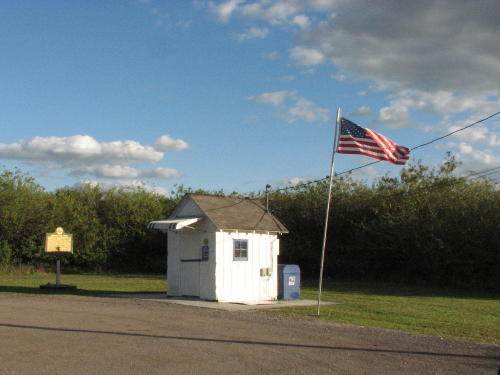 Our
curiosity got the best of us.
Our
curiosity got the best of us.
When we could turn around, we drove back to the little white building.
Sure enough, it was an active post office (since 1953).
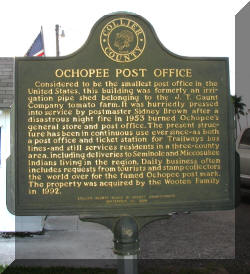 Click on this thumbnail photograph to read
the interesting history of the 'smallest post office' in the United States.
Click on this thumbnail photograph to read
the interesting history of the 'smallest post office' in the United States.
It started its life as a irrigation pipe shed.
It was worth the stop.
So, we were off again toward home.
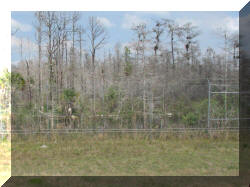
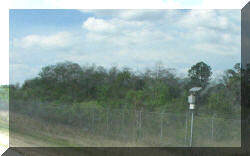 As
we traveled east on I-75, the 'new Alligator Alley', we discussed the fence that stretched for miles
on both sides of I-75. Again, our curiosity got us. We stopped in a rest area and asked a security guard
about the fence and solar powered boxes.
As
we traveled east on I-75, the 'new Alligator Alley', we discussed the fence that stretched for miles
on both sides of I-75. Again, our curiosity got us. We stopped in a rest area and asked a security guard
about the fence and solar powered boxes.
He told us that fence is monitored by the solar powered controls in the boxes. If a vehicle goes off the road and through the fence, the monitors report a breach in a specific segment of the fence so emergency personnel can locate the vehicle. Otherwise, a vehicle could go unnoticed 'forever' due to the total darkness or treed, swampy terrain of the area.
The just completed resurfaced area a couple miles from Big Cypress Campground
glowed in our headlights as we returned home.
We experienced another fun day in South Florida. Because of the way we did our sightseeing, the only cost was fuel for the truck and lunch for us.
MAIN PAGE - Florida Winter Tour - 2011